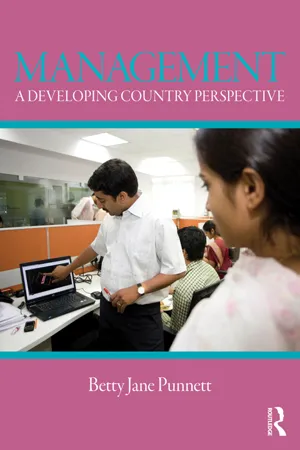Economics
Developing Countries
Developing countries are nations with lower levels of industrialization and income compared to more advanced economies. They often face challenges such as poverty, inadequate infrastructure, and limited access to education and healthcare. These countries are working to improve their economic and social conditions through various development initiatives and international assistance.
Written by Perlego with AI-assistance
Related key terms
1 of 5
9 Key excerpts on "Developing Countries"
- Chester Alexis C. Buama(Author)
- 2020(Publication Date)
- Society Publishing(Publisher)
A number of these countries have shown a higher GDP as compared to the developed countries since the late 1990s and there seems to be no consensus about the criteria that distinguishes a developing country from a developed one making it fall into either of the categories even though a general reference point in terms of the comparative GDP is available. At the same time, the least developed country should at all times be distinguished from a developing country. A Look into the Developing Countries 35 With a low HDI or Human Development Index and an industrial base that is not well developed, these nations are frequently referred to as underdeveloped countries. When compared to developed nations, the developing ones are characterized by lower economies, lesser money with people, lower life expectancy and the education standard is lower. These consist of sovereign states with a low HDI and relatively lesser industrialization as compared to the industrialized nations. There is a concentration of these countries in the global south whereby their technological and infrastructural development is relatively low. Developing Countries consists of the large array of countries that are generally lacking in optimal industrialization, sophisticated technology, an advanced living standard among its population, widespread literacy, other capital investment and infrastructure (also refer to IT Governance in the Public Sector in Developing Country); countries that are utilizing industrialization and making efforts towards an improvement of their conditions where the population has a low income per capita (also refer to ICT Policies in Developing Countries: Objectives, Issues, and Influencing Factors). When compared to developed countries, the Developing Countries are spread across the globe and are identifiable through their low social and economic factors (refer to Employing Active Learning and the Flipped Classroom Model in Developing Countries: Opportunities and Challenges).- eBook - PDF
- Adam Szirmai(Author)
- 2015(Publication Date)
- Cambridge University Press(Publisher)
1 Developing Countries and the concept of development This introductory chapter focuses on the concept of development. The low standard of living of the mass of the population in Developing Countries is singled out as the key issue in development. The development of per capita income over time and the factors that influence economic development or stagnation are important topics in this book. However, the interplay between economic and non-economic factors is of great importance for our understanding of the dynamics of socio-economic development. Economic development cannot be explained by economic factors only, and the concept of development includes more than mere changes in economic indicators. After a discussion of problems of involvement and detachment in the study of development issues in sections 1.1 and 1.2 , we examine the concept of development in sections 1.3 to 1.5 . Indicators of growth and development are presented in section 1. 6 . Section 1.7 highlights the differences between Developing Countries and the variety of development experiences . Section 1.8 examines global income inequality and poverty and highlights the increasing inequality in the international economic order . Section 1.9 addresses the question what Developing Countries have in common in spite of all their differences. The final section 1.10 provides a first introduction to the framework of proximate and ultimate causality which will be further developed in subsequent chapters. 1.1 Approaches to development ................................................................................................................. In discussions of development issues, two general approaches can be distinguished (see Myint, 1980 ): 1. The fi ght against poverty : This approach focuses on the problems of widespread poverty, hunger and misery in Developing Countries and on the question of what can be done in order to realise improvements of the situation in the short term . - eBook - ePub
Management
A Developing Country Perspective
- Betty Jane Punnett(Author)
- 2013(Publication Date)
- Routledge(Publisher)
The CIA Factbook notes that this listing is similar to the new International Monetary Fund (IMF) term “advanced economies” which adds Hong Kong, South Korea, Singapore, and Taiwan but drops Malta, Mexico, South Africa, and Turkey (CIA World Factbook accessed at www.cia.gov/library, July 16, 2010). Note that Hong Kong is not a country, but is in fact a part of the People’s Republic of China (PRC) (but it is often listed as a country, because of its special economic status within the PRC); the PRC does not recognize Taiwan as a country, and Taiwan does not currently have a seat at the United Nations. Developing Countries This term is used most commonly at the United Nations to describe a broad range of countries including those with both high and low per capita national incomes and those that depend heavily on the sale of primary commodities. These countries usually lack an advanced industrial infrastructure as well as advanced educational, health, communications, and transportation facilities. Wikipedia (www.wikipedia.org, accessed June 9, 2010) says simply “a developed country is one that has a high income per capita” and “a developing country is a country with a relatively low standard of living.” Although I would not normally recommend Wikipedia as a source of information, this definition captures the major distinction between the two groups. The specific measure that is usually used for determining a country’s status is income per capita. Using this measure, income per capita, according to the Economist Intelligence Unit (2006) the twenty-five developed countries of the world are: Australia, Austria, Belgium, Canada, Denmark, Finland, France, Germany, Gibraltar, Greece, Iceland, Ireland, Israel, Italy, Japan, Luxembourg, the Netherlands, New Zealand, Norway, Portugal, Spain, Sweden, Switzerland, United Kingdom, USA - eBook - PDF
Macroeconomics
A Contemporary Introduction
- William A. McEachern(Author)
- 2016(Publication Date)
- Cengage Learning EMEA(Publisher)
19-1a Developing and Industrial Economies The low- and middle-income economies are usually referred to as Developing Countries. Most high-income economies are also referred to as industrial market countries. So low- and middle-income economies, what are called Developing Countries, made up 82 per- cent of the world’s population in 2014 but produced only 48 percent of the output. Compared to industrial market countries, Developing Countries usually have higher rates of illiteracy, higher unemployment, faster population growth, and exports consist- ing mostly of agricultural products and raw materials. Most Developing Countries are also known as emerging market economies. On average, nearly half of the labor force in Developing Countries works in agriculture versus only about 3 percent in industrial market countries. Because farming methods are sometimes primitive in Developing Countries, farm productivity is low and some house- holds barely subsist. For example, over half the labor force in India works in agriculture, but that sector accounts for less than one-fifth of the nation’s output. 1 Industrial market countries, or developed countries, are primarily the economically advanced capitalist countries of Europe, North America, Australia, New Zealand, and Japan. They were the first to experience long-term economic growth during the 19th century. Developing Countries Low-income and middle- income economies; most are also known as emerging market economies industrial market countries Economically advanced capitalist countries of Europe, North America, Australia, New Zealand, and Japan; also known as developed countries and high-income economies EXHIBIT 1 Share of World Population and World Output From High-, Middle-, and Low-Income Economies as of 2014 Source: Based on population and output estimated from the World Bank’s World Development Indicators: 2015, Table 1. Find the World Bank at http://data.worldbank.org/products/wdi. - eBook - PDF
Microeconomics
A Contemporary Introduction
- William A. McEachern(Author)
- 2016(Publication Date)
- Cengage Learning EMEA(Publisher)
21-1a Developing and Industrial Economies The low- and middle-income economies are usually referred to as Developing Countries . Most high-income economies are also referred to as industrial market countries . So low- and middle-income economies, what are called Developing Countries, made up 82 per-cent of the world’s population in 2014 but produced only 48 percent of the output. Compared to industrial market countries, Developing Countries usually have higher rates of illiteracy, higher unemployment, faster population growth, and exports consist-ing mostly of agricultural products and raw materials. Most Developing Countries are also known as emerging market economies . On average, nearly half of the labor force in Developing Countries works in agriculture versus only about 3 percent in industrial market countries. Because farming methods are sometimes primitive in Developing Countries, farm productivity is low and some house-holds barely subsist. For example, over half the labor force in India works in agriculture, but that sector accounts for less than one-fifth of the nation’s output. 1 Industrial market countries, or developed countries, are primarily the economically advanced capitalist countries of Europe, North America, Australia, New Zealand, and Japan. They were the first to experience long-term economic growth during the 19th century. Developing Countries Low-income and middle-income economies; most are also known as emerging market economies industrial market countries Economically advanced capitalist countries of Europe, North America, Australia, New Zealand, and Japan; also known as developed countries and high-income economies EXHIBIT 1 Share of World Population and World Output From High-, Middle-, and Low-Income Economies as of 2014 Source: Based on population and output estimated from the World Bank’s World Development Indicators: 2015 , Table 1. Find the World Bank at http://data.worldbank.org/products/wdi. - eBook - PDF
Development Economics
Theory and Practice
- Alain de Janvry, Elisabeth Sadoulet(Authors)
- 2021(Publication Date)
- Routledge(Publisher)
In 2020, this category included 55 countries. • Middle-income countries with GNIpc from $1,026 to $12,475. These are frequently divided into: • lower-middle-income countries with GNIpc from $1,026 to $4,035—in 2019, this category included 53 countries; • upper-middle-income countries with GNIpc from $4,036 to $12,475—in 2019, this category included 56 countries. We also recognize the UN Capital Development Fund (2019) classification of Least Developed Countries, that have not only low GNIpc but also low basic needs indicators and high economic vulnerability (47 countries in 2019). Developed Countries, or More Developed Countries (MDCs), or Industrialized Countries Using per capita income, they correspond to the high-income countries (with GNIpc at or above $12,476). In 2019, this category included 85 countries, and 36 of the countries in this group are members of the Organisation for Economic Co-operation and Development (OECD). A Multidimensional Concept: The “Seven Horsemen of Underdevelopment” Achieving development is about reaching a satisfactory level of human wellbeing, both on average and for everybody in a particular country. While easy to say, this is complex to achieve because wellbeing is multidimensional, with no single agreed-on definition of what the dimensions are and with inevitable trade-offs in achieving the dimensions. In this book, we characterize development according to seven dimensions (presented in Chapter 1). Underdevelopment, the condition to be overcome by development, includes the following: 1. low levels of national per capita income relative to the industrialized countries and insufficient income growth to allow convergence in per capita income toward that achieved in the industrialized countries; 2. extensive material poverty accompanied by food insecurity and hunger; 3. inequality in the distribution of income and inequity in chances to succeed; 4. vulnerability to shocks and risk of falling into poverty and poverty traps; 5. - eBook - PDF
Global Monitoring Report 2011
Improving the Odds of Achieving the MDGs
- World Bank, International Monetary Fund(Authors)
- 2011(Publication Date)
- World Bank(Publisher)
Note: Unweighted simple averages. a. United Nations classification, a subset of Developing Countries. b. World Bank classification, a subset of emerging and Developing Countries. financial inflows, expressed relative to GDP, actually fell farther in 2010—suggesting that many recipient countries may not yet be shar- ing in these increases (table 2.2). Net finan- cial flows to Developing Countries in 2011 are projected to reach 13 percent of GDP, near the average for 2007–08. Inflows of FDI are lagging other signs of recovery, both in emerging market and Developing Countries (table 2.2), 6 although increases in workers’ remittances to precrisis levels have partly offset this (table 2.3). 7 Twin-track macroeconomic policies reflect the uneven economic recovery In advanced and some emerging market economies, as the impact of fiscal stimulus wanes and active fiscal adjustment begins, highly supportive monetary policy remains important for a more vigorous recovery. But policy makers must address the social costs of continued high unemployment (including high youth unemployment in some countries) at the same time. 8 Most emerging economies G L O B A L M O N I T O R I N G R E P O R T 2 0 1 1 E C O N O M I C G R O W T H I N D E V E L O P I N G C O U N T R I E S 53 face different challenges, including incipient inflationary pressures and, often, a need to rebalance growth toward domestic sources. Accordingly, among Developing Countries and particularly among emerging market economies, the macroeconomic policy mix shifted notably in 2010. Following the com- bined monetary and fiscal loosening by most emerging market economies in the face of contracting global output in 2009, one-third undertook both monetary and fiscal tighten- ing in 2010 (figure 2.11). As global conditions improved, Developing Countries also began to reverse their countercyclical policies. - eBook - PDF
Human Geography
People, Place, and Culture
- Erin H. Fouberg, Alexander B. Nash, Alexander B. Murphy, Harm J. de Blij(Authors)
- 2015(Publication Date)
- Wiley(Publisher)
Indeed, regardless of which came first, the fact remains that millions of people throughout the periphery are burdened with familial, economic, cultural, and political up- heavals. In this section of the chapter, we will discuss several of the conditions that affect the economic development prospects of people in the poorest countries of the world, including many factors outlined in the UN Millennium Development Goals. SOCIAL CONDITIONS Countries in the periphery face numerous demographic, eco- nomic, and social problems. As noted in Chapter 4, most of the less well-off countries have high birth rates, along with a FIGURE 11.13 Malala Yousafzai receives the 2014 Nobel Peace Prize. Malala Yousafzai is a children’s and women’s rights activist from Pakistan. As a girl, she defied the Taliban in Pakistan, demanding that girls have access to education. In 2012, when she was 15 years old, Malala was shot in the head by a Taliban gunman on her way home from school. She survived the attack and continues to speak out internationally about the importance of education. In 2014, she became the youngest person to receive the Nobel Peace Prize. Odd Andersen/AFP/Getty Images Trafficking When a family sends a child or an adult to a labour recruiter in hopes that the labour recruiter will send money, and the family member will earn money to send home. 11.3 What Are the Barriers to, and the Costs of, Development? 327 into working in conditions that they would not choose.” This phenomenon is not considered slavery because the family does not sell a child; instead, the child is sent away with a recruiter in the hopes that the recruiter will send money and the child will earn money to send home. The trafficked children are often taken to neighbouring or nearby countries that are wealthier and in need of domestic servants. Others are trafficked across the world, again typically to work as domestic servants. - eBook - PDF
Striving For Peace, Security And Development In The World: Annals Of Pugwash 1991
Annals of Pugwash 1991
- Joseph Rotblat(Author)
- 1993(Publication Date)
- World Scientific(Publisher)
Concluding Remarks The LDCs are poor because their resource economies are poor, but they have also been unable to manage properly what they have. They are generally in a state of chronic food insecurity and quite vulnerable to changes elsewhere. Their population is growing rapidly and employment generation is far behind the increase in the labour force. And they have no margin for error. It has to be stressed that the LDCs do not have sufficient time for catching up with the rest of the world, and they lack an initial critical mass or threshold for internally sustainable development. These countries face enormous problems which can be solved only through the combined action of the industrialized countries and the LDCs themselves. And the beginning has to be made by managing their human and material resources efficiently. To conclude, if no human effort is made to correct the situation outlined here, we may never be in a position to take up the greatest challenge mankind has ever faced: permanent peace and prosperity in the world we live in. 176 STANDARDS OF LIVING IN THE LEAST DEVELOPED COUNTRIES Andrew Haines Introduction Traditionally, development has been equated with economic growth. However, a number of authorities, including the United Nations Development Programme, have made a strong case for measures of human well-being as indicators of development. National income figures by themselves do not indicate the distribution of income within a population or put a value on human attainments such as better education, reduction in infant mortality, or increase in life expectancy. Other factors, such as security against crime and violence, improved working conditions and freedom of expression, also determine quality of life.
Index pages curate the most relevant extracts from our library of academic textbooks. They’ve been created using an in-house natural language model (NLM), each adding context and meaning to key research topics.








